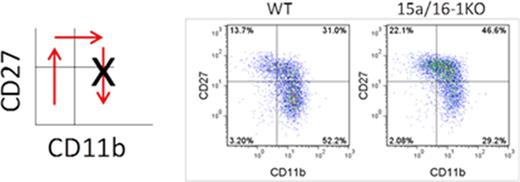Abstract
Natural Killer (NK) cells are lymphocytes that are important for early host defense against infectious pathogens and malignant transformation. NK cells differentiate from the CLP in the bone marrow, where they are identified by markers such as CD56 and NKp46 in humans, and NK1.1, CD122, and NKp46 in mice. NK cells further mature in the periphery, and this maturation is essential for NK cell function, as both NK cell cytotoxicity and IFN-g production are dependent upon maturation. NK cell maturation is distinguished by surface marker transitions, including CD56bright to CD56dim in humans, and loss of CD27 expression in mice. However, the factors controlling NK cell differentiation and maturation are incompletely understood. We hypothesized that the transcription factor Myb had a role in this process, due to its high expression in immature NK cells and subsequent loss upon maturation.
miRNAs are a family of small RNA molecules that control a wide variety of cellular processes via binding to target sites in the 3'UTR of messenger RNAs and downregulate protein production. The miR-15/16 family is very highly expressed in NK cells, and directly targets the 3'UTR of Myb. We hypothesized that a miR-15a/16-1KO mouse would have NK cell-intrinsic alterations in Myb levels, and would serve as a model of Myb upregulation. Here, we use lentiviral overexpression in primary human and mouse NK cells, as well as an in vitro human NK cell differentiation system, to demonstrate that Myb has critical roles in the NK cell differentiation and maturation processes. Furthermore, we generate a novel mouse model of miR-15/16 deficiency, and show that miR-15/16 is critically important for the regulation of Myb levels, and disruption of miR-15/16 prevents appropriate NK cell maturation.
In order to investigate the role of Myb in NK cells, we transduced human NK cells, and cultured them in vitro. After 5 days of culture, GFP+ NK cells overexpressing Myb remained CD56bright (84±3 v. 6±2%, p<0.01), whereas NK cells expressing GFP only had differentiated to CD56dim (16±2 v. 94±3%, p<0.001). Mouse CD27+ NK cells were transduced with the same viruses, and adoptively transferred and allowed to mature for 7 days in their new hosts. 0% of NK cells overexpressing Myb matured to CD27-, while 11% of GFP only matured, and 22% of NK cells with knockdown of Myb matured to CD27-. Thus, cells overexpressing Myb have a block in maturation, and Myb downregulation is essential for complete NK cell maturation.
To further investigate the role of Myb, we lentivirally transduced and cultured CD34+ progenitors in NK cell differentiation conditions. We found that cells overexpressing Myb had an increased percentage of immature CD56bright NK cells, which arose with more rapid kinetics (91±8 v. 28±16%, p<0.001 at day 14) [Fig. 1]. However, at later time points, cells overexpressing Myb failed to differentiate from CD56bright to the more mature CD56dim NK cells (8±6 v. 64±11%, p<0.01 at day 21). In contrast, CD34 cells transduced with an shRNA directed against Myb, differentiated to CD56dim NK cells more rapidly than control cells (90±7 v. 65±11, p<0.05 at day 21). Therefore, Myb drives initial NK cell differentiation, but prevents final maturation of NK cells.
Myb enhances initial NK cell differentiation from CD34+ cells, but prevents final maturation to CD56dim NK cells
Myb enhances initial NK cell differentiation from CD34+ cells, but prevents final maturation to CD56dim NK cells
We found that Myb is a direct target of miR-15/16, as overexpression of miR-15/16 reduces the signal of luciferase fused to the 3'UTR of Myb by 50% (p<0.001), while a sponge directed against miR-15/16 increases signal by 40% (p<0.001). Therefore, we generated a novel mouse model of NK cell-specific miR-15a/16-1 knockout driven by NKp46 (Ncr1), and confirmed that Myb expression was increased in miR-15a/16-1KO NK cells (9-fold in CD27+ NK cells, p<0.05). No early differentiation phenotype was observed, because Cre is expressed later, after NK cell lineage determination. In contrast, these mice lacked mature NK cells (31±4 v 62±6 %CD27- of splenic NK, p<0.01, Fig. 2). Additionally, miR-15a/16-1 overexpression in human CD34+ cells recapitulates the phenotype of Myb knockdown, establishing a direct link between miR-15/16 and Myb [Fig. 1]. Therefore, miR-15/16 controls Myb expression in a cell-intrinsic manner, and thereby directs NK cell differentiation and maturation.
miR-15/16 disruption increases Myb expression and prevents final maturation to CD27-
miR-15/16 disruption increases Myb expression and prevents final maturation to CD27-
No relevant conflicts of interest to declare.
Author notes
Asterisk with author names denotes non-ASH members.




